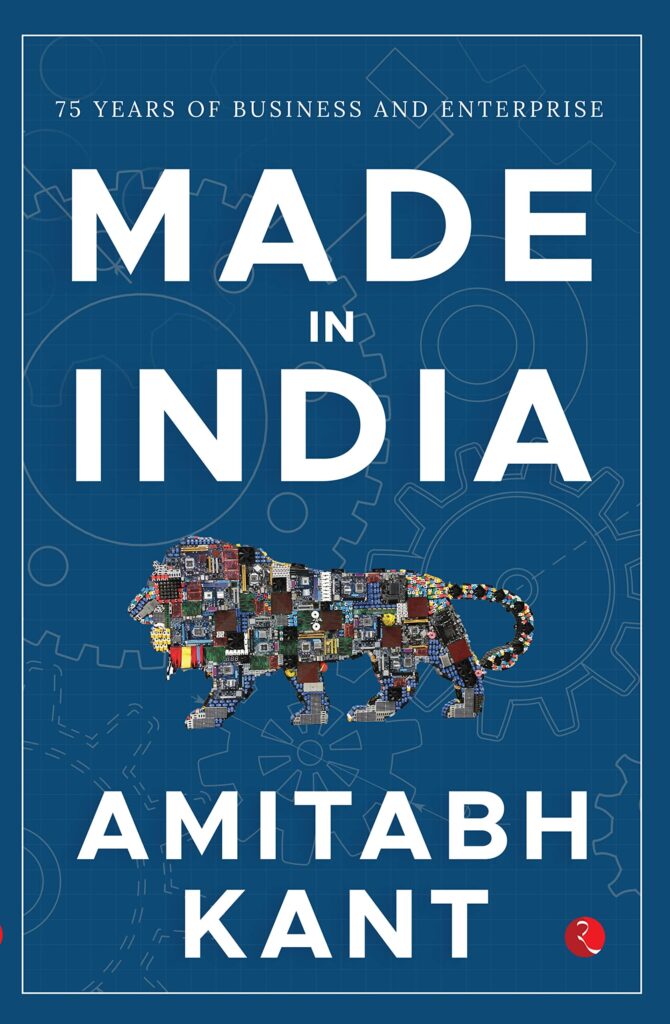Amitabh Kant’s new book, Made in India, is a fast paced account of India’s economic rise to become the fifth largest economy of the world.
There was a time when any product with the label Made In India was considered inferior. Lack of quality standards, poor manufacturing practices were prevalent in the Indian economy commanded by the government. At a time when government decided who should produce and in what quantity, consumers felt fortunate just to have acquired a product. From vehicles to food products to pharmaceuticals, most Made in India products were poorly created.
India has come a long way in the last 50 years. The opening up of the economy by former Prime Minister P.V. Narasimha Rao unleashed waves of changes that have positively impacted the Indian industry.
In his new book, Made in India, G20 Sherpa and former CEO of NITI Aayog, Amitabh Kant has tracked the sweeping changes across various sectors. The book is a fast paced account of India’s economic rise to become the fifth largest economy of the world.
“Once a leader in the global economy, centuries of colonization saw India being deindustrialized and falling behind. Indian entrepreneurs reignited Indians industrialization efforts in the late colonial era, but India moved from British Raj to License Raj,” Kant writes. “Strangling private enterprise was achieved not just through controls but by various laws including labour laws.” The Industrial Policy resolution of 1956 created three categories of industries which marginalized the role of private sector. It would take nearly 40 years before private sector was allowed to play a dominant role in industrial activities.
Kant gives insightful details of the impact of regressive laws on entrepreneurship and innovation. His analysis of various laws that stifled private enterprise is an important study for policymakers in central and state governments.
The reforms of the 1990s abolished the licence raj and allowed private enterprises to enter sectors reserved for government owned companies.

The second strong wave of reforms occurred under the leadership of Prime Minister Atal Bihari Vajpayee. Several important changes took place in government’s approach towards private sector. Private companies were incited to bid for airport construction and management for new terminals in New Delhi, Hyderabad and Bangalore. This was epochal since the sector had been reserved for government owned Airport Authority. While private airlines had been launched, the airports were still run by the government. The Vajpayee government decided to involve private and government owned companies. Strategic investors were asked to bid for companies in sectors like telecom, hospitality and minerals. The removal of quantitative restrictions allowed imports of several categories of consumer products. Until 2003, the government would decide how many items of a specific product could be imported. These restrictions were removed as part of commitment to follow the rules of the World Trade Organisation. Over time the import duties on most products were reduced. As the demand and markets increased, many global companies set up local manufacturing in India to cater to domestic consumers.
Kant had a ringside view and was an active participant of the fresh wave of economic reforms under Prime Minister Narendra Modi. As the Secretary in the Department of Industrial Policy and Promotion and later as CEO of NITI Aayog, which was earlier called the Planning Commission, Kant helped create and implement several path-breaking policy initiatives. The change of name, profile and objective of Planning Commission to NITI Aayog was itself a sign of things to come under the Modi government. For decades Planning Commission had symbolized the government’s economic planning under a socialist framework.
This wave of reforms since 2014 has included deep fundamental shifts that have changed the dynamics of the Indian economy and industry. The Insolvency and Bankruptcy Code brought accountability to business owners. Until then, it was nearly impossible to remove business owners who had taken credit and defaulted. Many had become serial defaulters. Under IBC they were forced out of their companies while lenders took charge of the future. Similarly the introduction of Goods and Services Tax ensured that the entire country became a single unified tax regime
Kant gives insider details about many policy changes and the thinking that drove the decisions. The policy efforts taken by government to improve India’s ranking on the Ease of Doing Business Ranking of the World Bank; and the push for higher foreign direct investment make for fascinating reading. The latest set of policy has been focused on reducing India’s dependence on imports. The production linked incentive scheme has been extended to several sectors to ensure that India could become a maker and not just a user of various products. From toys to electronics to pharmaceuticals, the PLI scheme is already showing impressive results.
Made in India spans across several decades and maps India’s transition from being deindustrialized to becoming a socialist economy. Then it chronicles the steady transformation into an industrial innovator and a digital economy. The chapters are structures into section which profile different phases of India’s economic history. Lastly, it also makes a bold case for India for the next 25 years.
Kant’s account includes anecdotes of various turning points in the economic policy making of which he was an active contributor. He has focused on the straight telling of facts, allowing the reader to appreciate the impact of decisions through the decades.
Government has transformed itself at various levels. From micro managing the production of two-wheelers to incentivizing Indian industry to invest in high tech sectors. Made in India is an important book for understanding the various challenges that the Indian economy has overcome. The book ends with an exciting glimpse into how the current achievements will propel India as a global leader in enterprise and innovation.
Pranjal Sharma is a geo-economic analyst and author based in New Delhi.

